| Physics 202 |
Intro to Astronomy: Lecture #6
|
Prof. Dale E. Gary
NJIT
|
Tools of Astronomy
Telescopes
There are many kinds of telescopes,
but they all have the same primary purpose--to collect light. By light, we
mean any part of the electromagnetic spectrum, not only visible light. Thus,
we have radio telescopes, and X-ray telescopes, and even gamma-ray telescopes.
As we will find, the shape, size, and internal workings of telescopes depends
a great deal on what part of the electromagnetic spectrum it is designed to
work for. We begin the discussion with the most familiar type of telescope,
the optical telescope.
The two main types of optical
telescope:
|
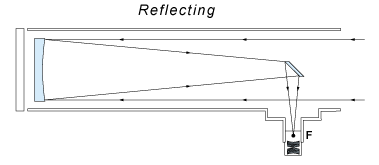
Reflecting
Telescope -- uses
a curved mirror to focus the light (like a shaving mirror).
|
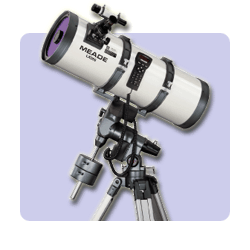 |
|

Refracting
Telescope -- uses
a lens to focus the light (like eye-glasses). Refraction means light-bending.
The light bends (changes direction) because it slows down on passing
through the glass. Red light slows more than blue.
|
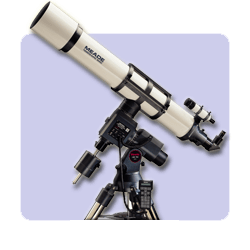 |
Advantages of reflecting telescope
over a refracting telescope:
| A
refracting telescope uses a lens, which bends red light more than blue
light, so the image has color halos. This is called chromatic
aberration. |
A
reflecting telescope reflects all wavelengths of light at the same angle,
so there are no color halos. |
| A
lens has two surfaces to be figured, which is more difficult to control
its shape. |
A
mirror has only one surface to be figured, so it is easier to control
the shape. |
| A
lens passes light through, so the glass has to be very transparent and
pure, and some wavelengths (infrared and ultraviolet) are absorbed by
glass. |
A
mirror reflects the light, so the material that it is made from does not
have to be transparent, and infrared and ultraviolet light reflects equally
well. |
| A
lens can only be mounted by its edges, so a large lens can sag under its
own weight. |
A
mirror can be supported from the back, so it is less subject to sagging.
Also, a mirror can be hollow, to reduce weight. |
Most of the problems for refractors
are worst for very large telescopes, so all large
telescopes today are reflecting telescopes. The largest refractor
has a diameter of 40" (about 1 m) compared to the largest reflecting
telescopes of 10 m aperture. However, it is possible to make very good small
refractors, and in fact refractors are more common than reflectors for the
telescopes below about 4" diameter.
Functions of a Telescope:
Most people would say that the
main function of a telescope is to make things look larger. But in fact, the
most important function is to make things look brighter!
This is called its light-gathering power.
If you enlarge an object, it gets fainter because you are spreading the light
over a larger image, so any telescope has a limit to how much magnification
it can comfortably deliver. Another important function of the telescope is
resolving power. This measures how well
you can separate two objects, and of course this is related to how sharp the
image looks.
Both of these functions, light
gathering power and resolving power, depend only on the size of the telescope
(called the aperture). The light gathering
power depends on the area of the main element (the objective), while the resolving
power depends on the diameter.
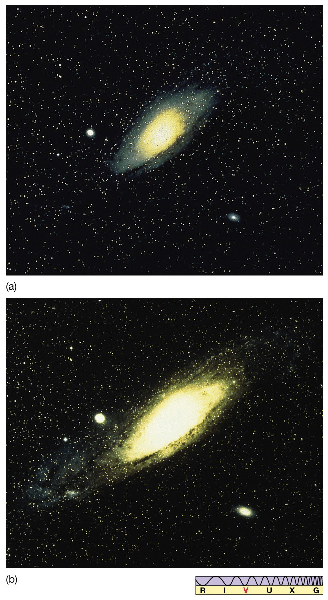
Two images showing the effect of lesser (top) and greater (bottom)
light gathering power. (From Chaisson/McMillan, Astronomy-4th edition)
|

Images showing the effect of worse (top) to better (bottom)
resolving power. (From Chaisson/McMillan, Astronomy-4th edition)
|
A telescope of aperture (diameter)
2D
has four times the light gathering power and twice the resolving power of
a telescope of aperture D.
The resolving power, however, depends inversely on wavelength, while light-gathering
power does not depend on wavelength. A telescope that operates in the visible,
at a wavelength of 500 nm (nanometers, 1 nm = 10-9 m) in the visible
has a resolving power that is 10 times better than one of the same diameter
that operates at 5 microns in the infrared (1 micron = 10-6 m).
The relationship between resolving power and aperture size is
angular
resolution (arcsec) = 0.25 * wavelength (microns) / telescope diameter (m).
The goals of modern astronomy
that fuel the drive to ever larger telescopes are (1) to see to the greatest
distance -- i.e. faintest objects, and (2) to measure spectral lines with
the best precision. Since spectra are measured by spreading light out as much
as possible, again we want the greatest possible light-gathering power. But
what about resolution (resolving power)? That is equally important, but there
is a limit to how well we can resolve objects that is not set by the aperture,
but rather by the blurring due to Earth's atmosphere.
Even the largest telescopes can only resolve objects to not much better than
0.3-0.5 arcsec, even when their theoretical resolving power is only 0.02 arcsec.
That is why the Hubble Space Telescope was launched, to get above the Earth's
atmosphere. In fact, the Hubble has a mirror diameter of only 2.4 meters,
compared to the Keck telescopes' 10 m diameter, yet the Hubble has about 10
times better resolution that the Keck.
Lecture Question
#1
Detectors and Image Processing:
Not so long ago, all astronomical
imaging was done with photographic film. Today, film is no longer used by
professionals, having been replaced by CCD cameras (just as digital cameras,
which work on the same principle, have replaced film cameras in everyday use).
CCD cameras have several important advantages:
- Better sensitivity (quantum efficiency),
typically 70% compared to film's 5% efficiency. That means an image at a
certain brightness level can be taken 10-15 times faster with a CCD.
- Better linearity. If you double
an objects's brightness, it will give a signal twice as great in the CCD
camera, whereas film will saturate.
- Digital precision. One can read
out the signal directly into the computer for processing, while for film
the image must first be digitized.
As the images below show, it is possible
to do digitial image processing on computer images taken with a CCD in order
to correct for instrumental effects. Here the first picture (a) is a ground
based image of a star cluster. In (b) is the same cluster seen with the Hubble
before its repair mission in 1994. In (c) is the Hubble image after image
processing to remove some of the effects of the optical errors. In (d) is
the Hubble image after the repair mission in 1994.

(From Chaisson/McMillan, Astronomy-4th edition--last
image modified for correct rotation, translation, and color table)
Two relatively new techniques are
being developed called Active Optics and
Adaptive Optics. Active Optics means
actually changing the shape or tilt of the mirror to correct for shape distortions
due to gravity or other mechanical distortions. The Keck 10 m telescopes,
for example, use 36 mirrors of 1.8 m diameter, and actively steer them to
align them as if they were a single 10 m mirror. Such shape changes are relatively
slow, taking seconds or more to change the shape. Active Optics does not correct
for the fast-changing atmosphere. Adaptive Optics means actually measuring
distortions in real time and changing the shape of the mirror as fast as 1000
times per second. Adaptive Optics can actually take out the distortions of
the atmosphere and improve the resolution of the images beyond what is normally
possible from the ground. Here is an example of the improvement possible:
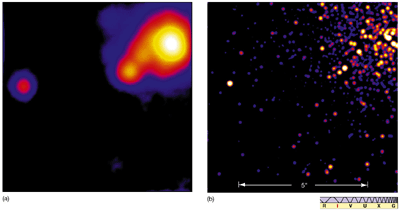
Left panel is an image from the ground without adaptive optics,
and the image on the right is from the same telescope with adaptive
optics turned on. (From Chaisson/McMillan, Astronomy-4th edition)
Radio Astronomy
The universe not only shines in visible
light, but also in the "light" of radio emission. Recall that any
hot object emits light of all wavelengths, and some of this light is in the
radio range. Here
are some images of the radio sky. Radio telescopes can look like a satellite
dish (in fact, a satellite dish is a radio telescope if you point it at an
astronomical object like the Sun), but they can also look quite different.
Check out this
link again, and go to the bottom part of the page to see some pictures
of radio telescopes.
One thing that is possible in radio
astronomy is to use interferometry, which
combines the signals from an array of antennas
as if they were all part of the same aperture. That means that the resolving
power of a radio telescope is not just what it would be for each antenna alone,
but is as for a single telescope the size of the separation between antennas.
This separation can be as large as you want--up to the size of the Earth itself.
If you put radio antennas in space, even larger separations are possible.
Currently, radio arrays give the best resolution of any kind of telescope--down
to milli-arcsec (1/1000th of an arcsec).
Advantages of Radio Astronomy
Radio astronomy has several advantages
over optical astronomy:
- We can see things that are invisible
in the optical wavelengths (opens up a new window on the universe).
- We can learn about conditions such
as high temperatures, high energies, magnetic fields, and composition (what
things are made of in space).
- We can make the highest resolution
images, and see things happening on the smallest scales.
What we have learned about interferometry
is now being adapted to work with optical light. So far, the technique only
works for very bright objects, and with arrays of only a few telescopes. But
when all of the difficulties are solved (if ever), the higher wavelengths
of optical astronomy will allow astounding spatial resolution.
Other Astronomies
Of course, telescopes that gather
"light" in other parts of the electromagnetic spectrum are also
being used to open up new windows on the universe. For example, infrared,
ultraviolet, X-ray, and gamma-ray light can be imaged and studied. But there
is one big difference. Optical and radio emission
reach the ground, but infrared, ultraviolet, X-ray, and gamma-ray emissions
do not. One has to go above the atmosphere, using either high-altitude
balloons or spacecraft. For example, a new space-based telescope, called SIRTF
(Space InfraRed Telescope Facility)
was just launched in 2003.
Infrared astronomy is important because
it is sensitive to very cool objects
and also because it allows us to see right through
dust. It turns out that cool, dusty places are where stars are
born. Here is a visible-light image of a star-forming region compared with
images taken in different IR bands:
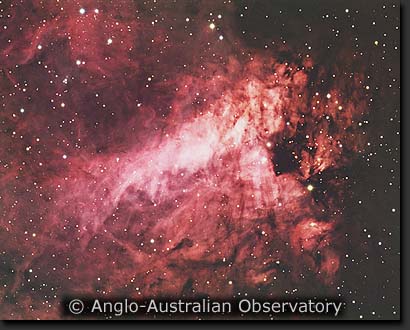 |
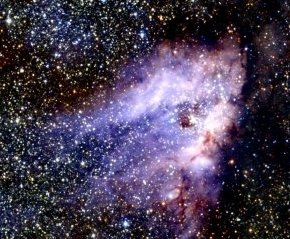 |
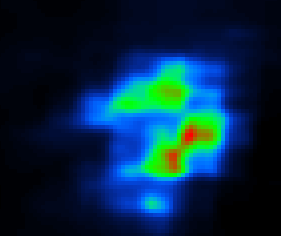 |
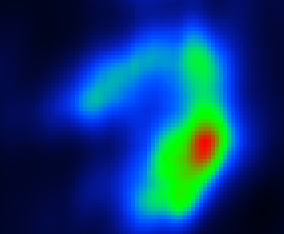 |
|
Optical
Image (c) AAO
|
Near
IR image (2MASS)
|
Mid-IR
image (IRAS 25 micron)
|
Far-IR
image (IRAS 100 micron)
|
You can see that the dark regions
of the optical image (dust clouds) are actually the brightest part of the
IR images, showing that the dust is the coolest part of the region (actually
about -150 C).
In the ultraviolet (UV), we have just
the opposite situation. UV is most sensitive to hotter regions than is visible
light. We can also make images in the X-ray and gamma-ray parts of the electromagnetic
spectrum--but it is not easy! How do you reflect or refract photons that go
right through you (like X-rays)? Here is a nice web site to see how
different objects in the sky look in different wavelengths.
Lecture Question
#2











